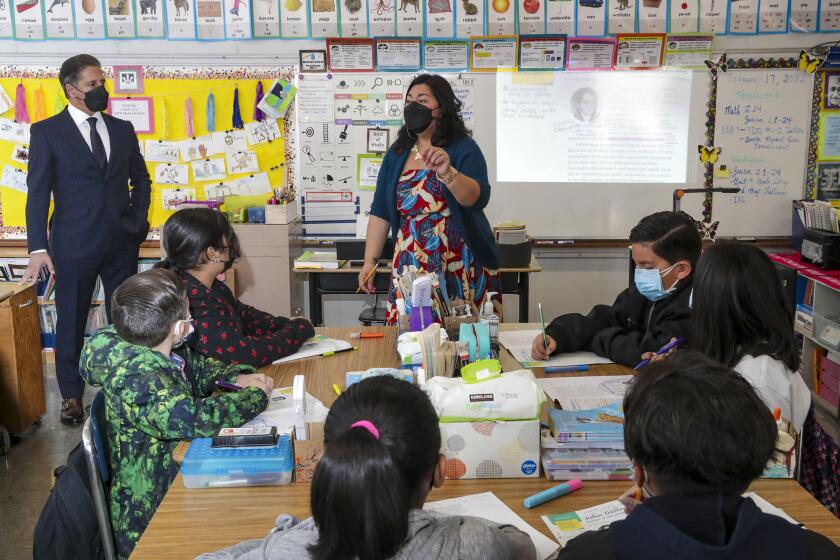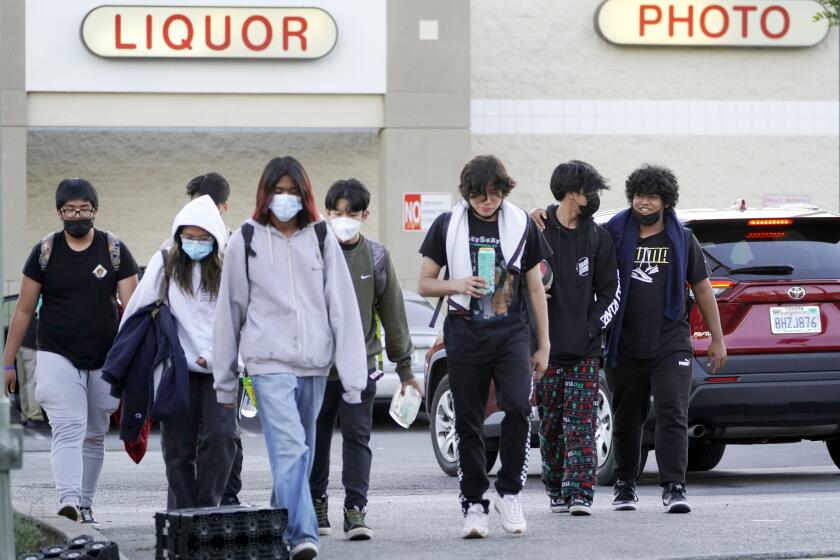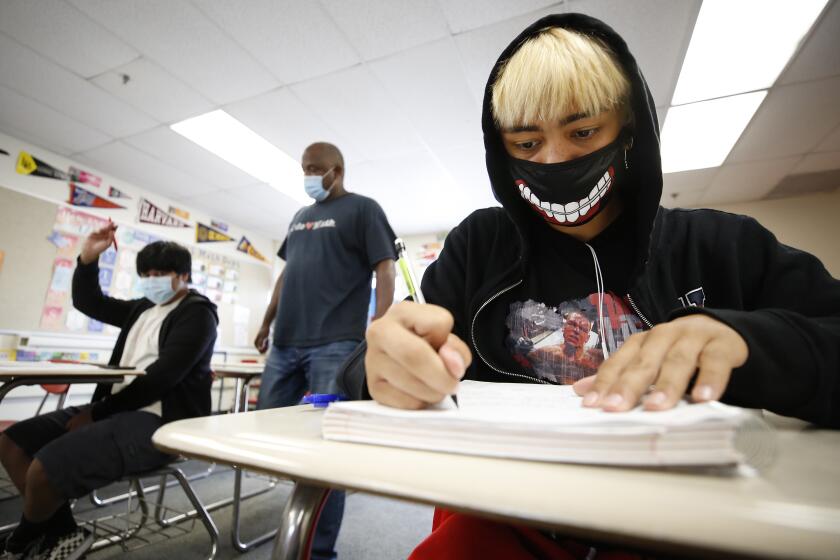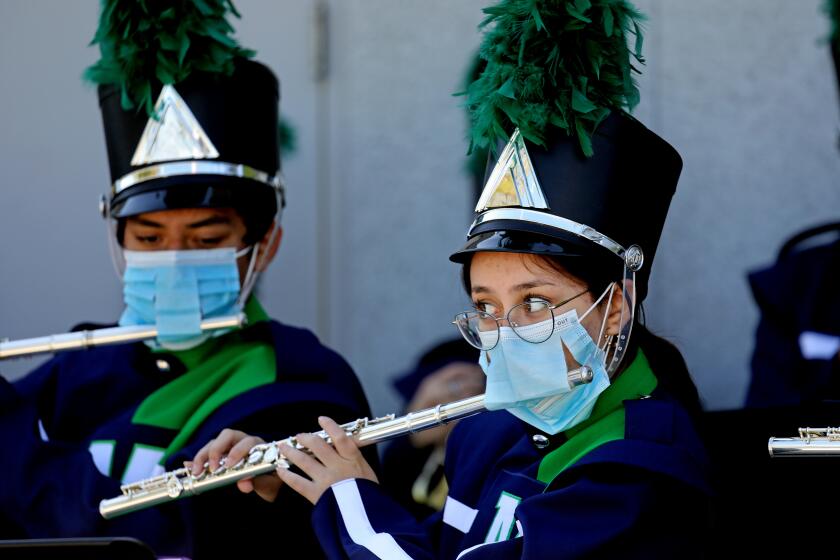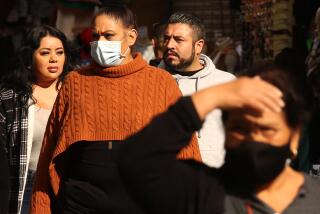L.A. County likely to drop indoor mask order Friday
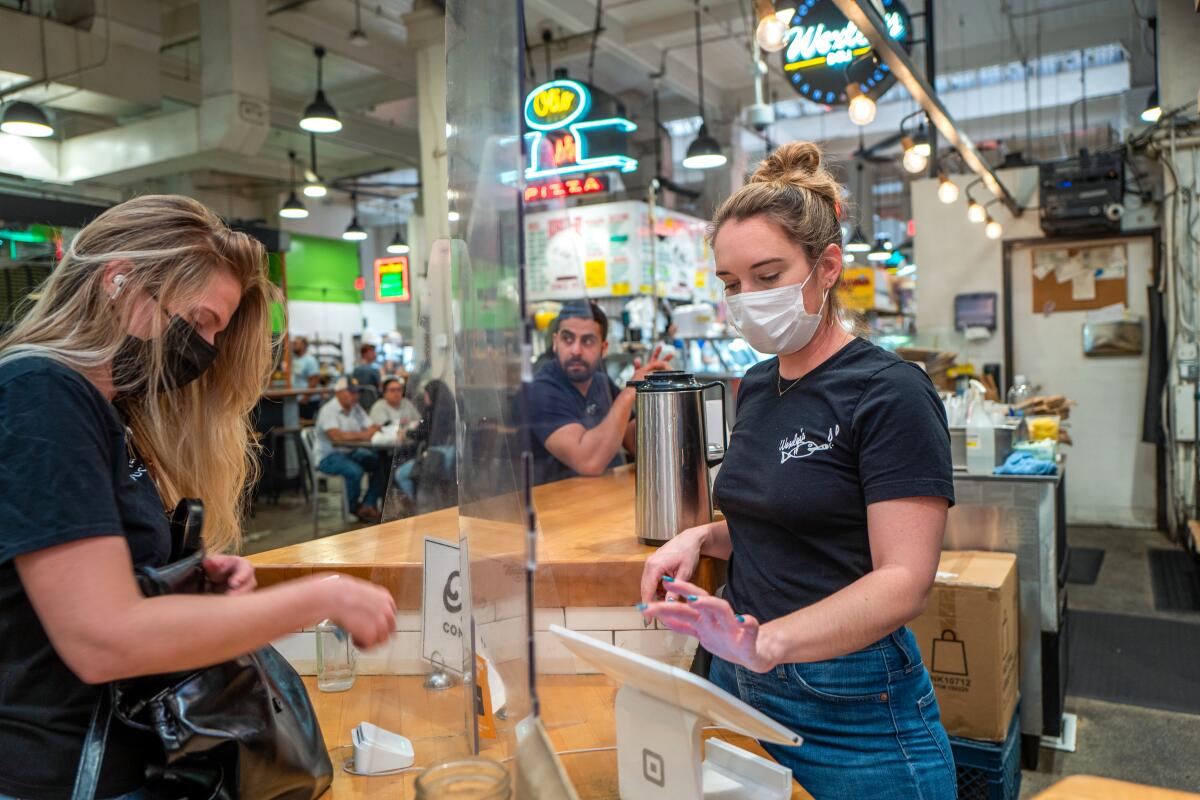
Los Angeles County will likely lift its universal indoor mask mandate Friday, a significant acceleration of the expected timeline following changes in federal face-covering guidance.
While nothing is set in stone, the potential changes would align L.A. County’s mask rules with those unveiled Monday by the California Department of Public Health, meaning it would be strongly recommended — but not required — for both vaccinated and unvaccinated residents to wear masks in public indoor settings.
“As we’ve emphasized throughout the pandemic, masks are one of the easiest things we can do to prevent COVID-19 transmission and provide strong protection to the person wearing them as well as to the people around them,” county Public Health Director Barbara Ferrer told the Board of Supervisors on Tuesday.
Ferrer also announced plans to relax some vaccine-verification rules in L.A. County. She said vaccine-or-test rules will no longer be required at outdoor mega events — such as at SoFi and Dodger stadiums and at the L.A. Memorial Coliseum and the Hollywood Bowl — and vaccination verification will no longer be required in indoor portions of bars, lounges, nightclubs, distilleries, wineries and breweries.
But the relaxation in L.A. County’s vaccine verification order won’t apply to cities with their own requirements. The cities of Los Angeles and West Hollywood have their own rules requiring restaurants, bars, gyms and other businesses to check for proof of vaccination before allowing customers to come inside.
Vaccine verification or a recent negative test will still be required at indoor mega events — those with more than 1,000 people, such as NBA games at Crypto.com Arena — a mandate from the state. Vaccination verification also is required for healthcare workers and employees at nursing homes.
The county’s new approach comes days after the U.S. Centers for Disease Control and Prevention announced it would shift to a county classification system that takes into account both coronavirus cases and COVID-19’s impact on hospitals. As part of that change, the number of areas in which the agency still recommended universal indoor masking shrunk dramatically — from much of the nation to about 37% of U.S. counties, where roughly 28% of Americans live.
Local officials will retain the option of keeping mask rules in place. More than 1,000 school districts face making their own decisions on when to take that step — contingent on health orders and labor agreements.
When the initial edition of the CDC’s “COVID-19 Community Levels” was released last week, L.A. County fell into the “high” category, in which masking is recommended for all in indoor public places.
However, federal data released since then indicate the county is positioned to soon move into either the “moderate” or “low” tiers, in which masking would no longer be recommended. It’s likely that L.A. County will officially fall to either of those two categories when the CDC updates its categorization of counties by community level on Thursday.
“We, along with the state and CDC, continue to urge individuals — regardless of their vaccination status — to keep their masks on in public indoor settings until there’s less risk for those most vulnerable,” Ferrer said.
The significant shift in federal thinking upended L.A. County’s timeline for relaxing its own indoor mask mandate, which was previously tied to the CDC’s old framework that sorted counties into four tiers based on their coronavirus case and testing positivity rates.
Under that blueprint, the CDC recommended universal indoor masking while in public unless a county was in the “moderate” or “low” tier of community transmission. In a county the size of L.A., that would have meant recording fewer than 730 new coronavirus cases a day over a weekly period.
L.A. County is now averaging about 1,800 new cases a day over the last seven days; the week before, it was averaging about 2,800 cases a day, and before that, 4,500 cases a day. At the peak of the Omicron wave, L.A. County was averaging 42,000 cases a day, a pandemic record.
While L.A. County health officials expressed confidence that the region would be in a position to ease indoor masking requirements for vaccinated people by mid- to late March, and a majority of supervisors backed the health department, the delay nonetheless drew criticism from some residents and other elected officials, who said the county should more immediately align its rules with more permissive statewide standards.
“I think it’s welcome news to a lot of residents in our county, and I think it’s going to make our policies less confusing and easier to follow,” Supervisor Janice Hahn said of the new masking approach.
However, Ferrer and supervisors alike noted that the new county guidance doesn’t mean it’s time for everyone to throw away their masks.
“I think it’s important for us to note that moving forward doesn’t mean that masks are irrelevant,” Supervisor Kathryn Barger said. “It means that it’s your choice.”
Dr. Mark Ghaly, California’s health and human services secretary, said this week that he’s strongly recommending mask use indoors statewide to further protect the vulnerable until case rates drop more.
Wearing a mask will help protect children still too young to be vaccinated as well as those who are vulnerable to severe COVID-19 and who are at greater risk for worrisome complications even if they are vaccinated, such as older people, those with weakened immune systems and people with many chronic conditions, including asthma, diabetes and lung and heart disease.
Continuing to wear a mask also will help reduce the chance of infection that could lead to long COVID, which can result even in people who did not suffer symptoms from their coronavirus infection. Long COVID can result in difficulty breathing, symptoms that get worse after physical or mental activities, and difficulty thinking or concentrating, sometimes referred to as brain fog.
And there remain severe inequities in which communities are hardest hit by COVID-19, with Black and Latino residents, as well as people living in poorer neighborhoods, still hospitalized and dying at far greater rates than those who are white or Asian American or living in wealthier areas — even among people with the same vaccination status.
“There are still communities that, for whatever reason, are significantly more impacted” by COVID-19, Supervisor Holly Mitchell said.
And Supervisor Hilda Solis voiced concern about low rates of immunization among children age 5 to 11. Fewer than 30% of L.A. County children in that group are fully vaccinated against COVID-19, compared to 76% of adolescents age 12 to 17.
Solis was worried that parents weren’t getting children vaccinated, not because of hardened anti-vaccination sentiment, but because of a lack of access to healthcare services and good information, especially in low-income areas.
Even though there may no longer be a mask mandate, experts say it still makes sense to wear them inside because they offer strong protection.
L.A. County’s universal indoor mask mandate has been in place since July, when officials reinstituted it during the early days of the surge fueled by the highly contagious Delta variant.
California, which celebrated its economic reopening just a month prior to L.A. County’s move, did not implement a similar statewide rule until December, following the arrival of the even-more-transmissible Omicron variant.
When the statewide rule expired in mid-February, allowing those vaccinated for COVID-19 to again go maskless in many indoor settings, L.A. County was one of only a handful of jurisdictions that did not immediately follow suit.
In the weeks since, the nation’s most populous county has become even more of an outlier. Most places that initially kept local mandates in place — including Santa Clara County and the cities of Palm Springs, Long Beach and Pasadena — have since aligned their rules with the state, or said they will do so shortly.
“We are very encouraged by the progress we have made. We have much less COVID spreading in our community as compared to two weeks ago or even a week ago,” said Dr. Sara Cody, health officer and director of public health for Santa Clara County, where indoor masking will no longer be required starting Wednesday. “While indoor masking in public spaces will no longer be required, it still makes sense to do. Wearing a mask is part of working together to protect others, especially the most vulnerable among us.”
California’s strict indoor mask rules at schools have helped prevent major coronavirus outbreaks on campuses.
L.A. County has significantly shifted its mask guidance in recent weeks. The county lifted its mask requirements for outdoor areas at K-12 schools and childcare facilities, as well as exterior areas of mega events, in mid-February. And starting last week, county health officials began allowing fully vaccinated individuals to shed their masks indoors at establishments that screen the inoculation status of visitors and patrons.
The rapid shift in masking rules comes as California steadily emerges from the Omicron surge, one of the pandemic’s most devastating phases.
The state has reported an average of just under 6,600 new coronavirus cases per day over the last week, according to data compiled by The Times. That’s down about 68% over the last two weeks.
Officials said masks will be strongly recommended — but no longer required — for unvaccinated individuals in most indoor settings starting Tuesday.
Coronavirus-positive hospitalizations are also tumbling statewide. On Monday, 4,129 such patients were hospitalized in California, including 927 in L.A. County — down 73% and 81%, respectively, from the heights recorded during the worst days of the Omicron wave.
Even as the coronavirus wave recedes, though, California is still paying a heavy price. Over the last week, an average of 170 Californians have died from COVID-19 per day, pushing the cumulative death toll above 84,700.
More than 30,400 Angelenos have died from COVID-19 throughout the pandemic.
More to Read
Sign up for Essential California
The most important California stories and recommendations in your inbox every morning.
You may occasionally receive promotional content from the Los Angeles Times.
